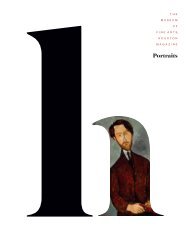Spring 2016 - High Style
You also want an ePaper? Increase the reach of your titles
YUMPU automatically turns print PDFs into web optimized ePapers that Google loves.
THE<br />
MUSEUM<br />
O F<br />
FINE ARTS,<br />
HOUSTON<br />
MAGAZINE<br />
<strong>High</strong> <strong>Style</strong>
THE THE<br />
MUSEUM<br />
O F O F<br />
FINE FINE ARTS , ,<br />
HOUSTON<br />
MAGAZINE<br />
02 02 Welcome<br />
07 07 Backstory<br />
09 09 Object Object Lesson Lesson<br />
10 10 In the In the Mix Mix<br />
<strong>High</strong> <strong>Style</strong><br />
Issue Issue 5 / <strong>2016</strong> 5 / <strong>2016</strong><br />
15 15 Up Up Close Close<br />
18 18 Portfolio<br />
31 31 Series Series<br />
34 34 Profile Profile<br />
38 38 Surfacing<br />
45 45 Five Five Minutes With With<br />
46 46 Exhibition Funders<br />
47 47 Credits Credits<br />
48 48 Coming Soon Soon
At the Starting Line of <strong>Style</strong><br />
Even in the midst of the Great Depression, imaginative coachbuilders embraced<br />
the flowing lines of the then-prevalent Art Deco style. With sensuous curves and<br />
streamlined forms, their innovative vehicle designs convey a sense of speed as well<br />
as luxury. Sculpted in Steel: Art Deco Automobiles and Motorcycles, 1929–1940<br />
showcases 17 prime examples, including rare concept vehicles and those made in<br />
limited production runs.
G A R Y T I N T E R O W , D I R E C T O R<br />
<strong>High</strong> <strong>Style</strong><br />
W E L C O M E<br />
02<br />
To arrive in style has always been a conspicuous expression of power, wealth, and taste, hence the Museum’s first<br />
exhibition of automobiles, Sculpted in Steel, provides the theme for this issue of h. The exhibition focuses on a select<br />
few automobile designers who sought to elevate the appearance of their vehicles from mundane efficiency to heights<br />
of elegance never before seen. More than a dozen splendid automobiles are included in the display organized by Cindi<br />
Strauss, Sara and Bill Morgan Curator of Decorative Arts, Craft, and Design, and Ken Gross, guest curator.<br />
These vehicles encapsulate the spirit of the age. The best cars of the 1930s deserve a place among the most<br />
extraordinary objects of the Art Deco period. To provide context, this issue features other stunning examples of design<br />
and fine art made between the two world wars—from photographs of Harlem nightlife and Josephine Baker in Paris<br />
to cocktail sets and portable phonographs.<br />
A self-made arbiter of style, the 19th-century painter Franz Xaver Winterhalter bestowed on his aristocratic subjects<br />
a beauty and grace that they did not always possess. Thanks to that remarkable talent, he became the preeminent<br />
portraitist of European royalty of his day. No artist painted as many monarchs—from Mexico City to Madrid, from London<br />
to St. Petersburg—as did Winterhalter. These royal portraits are brought together in the exhibition <strong>High</strong> Society,<br />
conceived and organized by curator Helga Kessler Aurisch. She shows how Winterhalter collaborated with couturiers,<br />
especially Charles Frederick Worth, the father of modern haute couture, to create iconic images. For the first time,<br />
nearly a dozen gowns by Worth and his contemporaries are featured alongside Winterhalter’s acclaimed portraits.<br />
<strong>Style</strong> is a theme that unites two of the Museum’s major initiatives of the past year—the MFA Shop and the<br />
MFA Café. Both have been renovated to reveal architect Rafael Moneo’s original designs for those two spaces. The<br />
new shop and its contents have been conceived by consultant Murray Moss, creator of the SoHo design mecca Moss,<br />
and it is nothing if not stylish. The MFA Café takes its cue from the north Italian region of the Veneto, birthplace of<br />
restauranteur Paolo Fronza. Serving Italian panini, pizza, pastries, and coffee, the MFA Café provides a pretext for displaying<br />
works from our collections that celebrate Italy and Italian artistry. The first rotation showcased Murano glass<br />
and Italian silver by the Memphis Group, as well as photographs of Venice. Eating in style means enjoying fine, fresh<br />
food in handsome surroundings.<br />
Our issue concludes with a Q&A with one of the most stylish women of our times: Museum of Fine Arts, Houston,<br />
Life Trustee Lynn Wyatt. Born a Sakowitz, of the eponymous Houston department store, Mrs. Wyatt gained entrée to<br />
the world of fashion and haute couture from the moment she could walk in high heels. Surprisingly, in her interview<br />
she explains how style has little to do with looks and fashion, and instead depends on character, grace, and an honest<br />
expression of values and identity. In Lynn Wyatt’s worldview, style is something each of us can achieve.<br />
Yours sincerely,
03
Va-va-vroom<br />
Designed by Alfred Böning, the BMW R7 Concept Motorcyle was built in 1934 as a one-of-a-kind concept motorcyle.<br />
The pressed steel frame, gracefully skirted front and rear fenders, fuel tank, and streamlined and fluted partial side<br />
covers for the engine were beautifully integrated. Nothing came close in the marketplace at the time. Finished in<br />
period BMW glossy black-and white–striped livery, the single-seater was once lost and long forgotten. It was stored<br />
in a crate for nearly 70 years before being discovered in 2005. The BMW R7 is one of three stunning motorcyles<br />
exhibited in Sculpted in Steel.<br />
04
05<br />
Flight of Fancy<br />
As an aircraft builder, Gabriel Voisin drew inspiration more<br />
from aviation and architecture, departing from the rounded<br />
feminine forms found in other Art Deco automobiles. The<br />
singular design of his 1934 Type C27 Aérosport Coupe borrows<br />
the angular shapes, crank-out windscreens, and sling-back<br />
seats found in planes.
06
See these and other stylish vehicles in Sculpted in Steel: Art Deco Automobiles and Motorcycles, 1929–1940,<br />
on view through May 30, <strong>2016</strong>, in the Brown Foundation Galleries of the Audrey Jones Beck Building.<br />
Art Deco in<br />
Overdrive<br />
Held in Paris in 1925, the International Exposition of Modern Industrial and Decorative<br />
Arts had a far-reaching influence in the years to come. The style that it promoted, later<br />
referred to as “Art Deco,” celebrated the modernity, luxury, efficiency, and streamlining<br />
of the machine age. By the late 1920s and 1930s, Art Deco was widespread, and could<br />
be seen in architecture, fashion, decorative arts, graphic and industrial design—and, of<br />
course, in automobile design.<br />
According to Cindi Strauss, the Museum’s Sara and Bill Morgan Curator of Decorative<br />
Arts, Craft, and Design, “Transportation design in the first half of the 20th century affords<br />
numerous opportunities to study the global influence of style. Although the Museum’s<br />
collection is rich in objects from the Art Deco period, it lacks automobiles and<br />
motorcycles. Sculpted in Steel: Art Deco Automobiles and Motorcycles, 1929–1940<br />
offers Museum visitors the opportunity to learn more about this important period in<br />
design history from the point of view of automotive innovation.”<br />
Several of the celebrated coachbuilders were based in France, where Art Deco got<br />
its start. The names Bugatti and Delahaye were synonymous with high style. It was<br />
in Paris that the designers Joseph Figoni and Ovidio Falaschi developed the stunning<br />
Talbot-Lago T-150C-SS Teardrop Coupe, taking curvaceous form to the extreme.<br />
Airplanes, as icons of the modern age, often served as inspiration for earthbound<br />
vehicles. The French aeronautical expert Gabriel Voisin applied his knowledge of<br />
aerodynamics to building cars that resembled wingless planes, such as the Type<br />
C27 Aérosport Coupe. The French aircraft designer Jean Andreau created the H6B<br />
Dubonnet “Xenia” Coupe for the engineer André Dubonnet in 1938. Meanwhile, the<br />
Czech company Tatra developed models that drew from zeppelin designs, such as the<br />
T97, which sports a sloping roof with a prominent rear dorsal fin, known as a “fast-back.”<br />
In the United States, William Bushnell Stout, who likewise had a background in<br />
aeronautical construction, produced the unusual Scarab—a radical beetle-shaped<br />
automobile with a rear engine and complex chrome detailing whose high price tag<br />
resulted in fewer than 10 being built. Thought to be the spiritual predecessor to today’s<br />
B A C K S T O R Y<br />
07
minivan, the Scarab had moveable seats, an interior table, and a back<br />
bench so that it could accommodate numerous passengers comfortably.<br />
Other American makers also embraced the Art Deco impulse.<br />
Chrysler unveiled the Imperial Model C-2 Airflow Coupe and a concept<br />
car called the Thunderbolt. Cord and Packard similarly created luxurious<br />
vehicles that boldly exhibited streamlined forms and Art Deco detailing.<br />
Art Deco styling was applied to motorcycles as well—as seen in<br />
the Indian Motorcycle Company’s popular Chief, with its curving fenders<br />
shaped to resemble war bonnets. Some were more beautiful than<br />
practical. The designer O. Ray Courtney produced a prototype KJ<br />
Streamline motorcycle for the American firm Henderson and Excelsior<br />
that featured a sweeping vertical grille and enclosed bodywork.<br />
Three extraordinary motorcycles and 14 automobiles are the stars<br />
of Sculpted in Steel, a version of which previously debuted at the Frist<br />
Center for the Visual Arts in Nashville in 2013. These exceptionally<br />
well-preserved and restored vehicles fully embody the Art Deco<br />
aesthetic. Their sleek curves and daring lines exemplify the optimism<br />
and ambition of the age.<br />
B A C K S T O R Y<br />
06
Driven to Design<br />
Based in Paris, the designers Joseph Figoni and Ovidio Falaschi touted themselves<br />
as the “Couturiers of the Automobile.” Their Delahaye 135MS Roadster was a unique<br />
design made especially for the 1937 Paris Auto Salon, where it dazzled with its voluptuous<br />
curves, skirted fenders, long hood, and swooping chrome details.<br />
07
08
This exquisite ewer is among the masterpieces in an outstanding collection of<br />
English silver recently given to the Museum of Fine Arts, Houston.<br />
P A U L D E L A M E R I E ’ S E W E R F O R T H E E A R L O F E L Y<br />
A Stylish<br />
Masterpiece of<br />
English Silver<br />
Focus on the<br />
Ewer for the Earl of Ely<br />
• The ewer is shaped like an inverted Roman<br />
helmet. The ewer form was popular from<br />
the 1660s for displaying on a buffet or for<br />
use on a toilet table for hand-washing.<br />
• The Rococo-style ornament includes many<br />
marine-related forms—scales, seaweed,<br />
shells, and waterfall motifs—all appropriate<br />
for a vessel made to hold water.<br />
• Continuing the aquatic theme, the handle<br />
features a mask that is likely the face of<br />
Neptune, god of the sea.<br />
• The fronds at the bottom not only serve<br />
as ornament but also strengthen the vessel,<br />
to support the weight of the exuberant spout<br />
and handle.<br />
• The engraved coat-of-arms indicates that<br />
the ewer formerly belonged to the Earl of Ely.<br />
• The motto incorporated into the coatof-arms<br />
reads “Prend moy tel que je suis,”<br />
or “Take me as I am.”<br />
A highly regarded collection of English silver has come to the Museum of Fine Arts, Houston, thanks<br />
to a generous gift from George S. Heyer, Jr., a longtime friend and Trustee of the Museum who<br />
passed away in October 2015. Dr. Heyer, an ordained minister and historian, was professor emeritus<br />
at Austin Seminary. When in his late twenties, Dr. Heyer visited an antiques show in New York and<br />
was captivated by the objects in the booth of an English silver dealer, inspiring a collecting effort<br />
that endured for many decades. The Heyer collection is one of the most select, thoughtful, and<br />
internationally renowned assemblages of English silver in the United States.<br />
“I have tremendous respect for Dr. Heyer and the silver collection he formed,” said Katherine S.<br />
Howe, director of Rienzi. “He truly took an intelligent, judicious approach in defining his collection.<br />
He focused on the very finest examples of silver made by London’s best silversmiths from 1660 to<br />
1760, who were known for their excellent design and craftsmanship. Dr. Heyer was a scholar who<br />
was keenly aware of everything going on in his field of collecting, and he was a delightful gentleman.”<br />
The silver represented in the Heyer collection was created during one of the most interesting<br />
periods in English history, beginning with the restoration of the monarchy to the throne in 1660 and<br />
ending with the death of King George II in 1760. These years coincide with a gradual transition in<br />
art and architecture from the more classically inspired shapes and ornament of the Baroque style<br />
to the more fanciful, asymmetrical exuberance of the Rococo. By the end of this era, England had<br />
grown from a regional to a world power, and London had become a wealthy, international city. Its<br />
nobility and upper classes could well afford to own impressive objects made of silver. London was<br />
also a haven for immigrants, some of them excellent silversmiths from France, Holland, and the<br />
German principalities. Paul de Lamerie (c. 1688–1751), a French Huguenot born in Holland, is one<br />
example of the fine immigrant silversmiths working in London who enlivened English silver with<br />
new shapes, ornament, and techniques.<br />
One of the highlights of the Heyer collection is this spectacular ewer, or water pitcher, c. 1735, by<br />
de Lamerie, who was active in London from 1703 to around 1751. It is designed in the fashionable<br />
Régence, or early Rococo, style that emerged in Paris in the late 17th century and was brought to<br />
England by Huguenot goldsmiths such as de Lamerie.<br />
O B J E C T L E S S O N<br />
09<br />
15 x 13”
Cosmopolitan <strong>Style</strong><br />
10<br />
How did the son of a Black Forest farmer achieve superstar status<br />
on the international royal circuit? The fascinating story of Franz Xaver<br />
Winterhalter (1805–1873), portraitist extraordinaire to the courts of<br />
Paris and London, Vienna and Berlin, and St. Petersburg and Madrid,<br />
in the 19th century, documents a painter’s prowess, panache, and<br />
suave style. Winterhalter’s success as a sought-after portraitist was<br />
unrivaled. Among the renowned European court painters who had preceded<br />
him, neither Titian, nor Peter Paul Rubens, nor Anthony van Dyck<br />
served as many sovereign rulers. Winterhalter achieved his success in<br />
part because of the increasingly close bonds that were being established<br />
between the royal families and aristocratic houses in Europe.<br />
New means of travel enabled both the artist and his esteemed clients to<br />
tour the Continent and visit the spectacular universal exhibitions held in<br />
Europe’s capitals, or to take the rejuvenating waters at celebrated spas.<br />
Above all, Winterhalter’s success is attributed to his astonishing<br />
talent. The artist could exquisitely capture the likeness of his sitters,<br />
depicting their figures and their often luxurious clothing in exacting<br />
detail. He painted people in a most favorable light, as they wished<br />
to see themselves, even though the social and political climates<br />
reflected a more complicated reality. Winterhalter began his career<br />
as a graphic artist for a publishing house in Freiburg, then trained in<br />
Munich, which was becoming the foremost artistic center in Germany<br />
during the 1820s. In Karlsruhe, Winterhalter solidified his relationship<br />
with the Grand Duke Leopold, who eventually appointed him as his<br />
court painter. Despite the assumption that the artist would dedicate<br />
himself entirely to the demands of his patron, Winterhalter soon departed<br />
for Paris, where he would settle permanently and make his lasting<br />
impression on high society.<br />
After Winterhalter’s increasingly well-received showings at the<br />
Paris Salons of the 1830s, the newly installed King Louis-Philippe<br />
commissioned the artist to paint more than 30 full-length portraits<br />
of his immediate family. Within a very short time, Winterhalter had<br />
become the de facto court painter of the “citizen king” who had ascended<br />
the throne following the revolution in 1830.<br />
Beguiling Beauty<br />
Both the size and horizontal format of this painting in rendering a single figure are unique in<br />
Winterhalter’s oeuvre, as is the sitter’s languorous pose. The combination of Princess Leonilla’s<br />
pose—with its allusion to Orientalist images of odalisques—and the lush, tropical landscape<br />
elevate this picture to a level somewhere between portrait and genre painting.
<strong>High</strong> Society: The Portraits of Franz X. Winterhalter will be on view from April 17 to August 14, <strong>2016</strong>,<br />
in the Upper Brown Pavilion of the Caroline Wiess Law Building.<br />
I N T H E M I X<br />
11<br />
56 x 83 1/2”
The magisterial portrait gallery at Versailles<br />
includes some of Winterhalter’s finest works,<br />
which already reflect his eventual signature style<br />
of slightly idealizing the features of his sitters as<br />
well as subtly elongating their bodies.<br />
An intricate web of family relationships linked<br />
one dynasty to another. Winterhalter had come<br />
to the attention of Louis-Philippe through the<br />
patronage of the king’s daughter, Queen Louise-<br />
Marie of the Belgians. She, in turn, provided<br />
Winterhalter with an entrée to her niece, Queen<br />
Victoria. Winterhalter invented what might be<br />
called the “glamour shot” of the British royal<br />
family: in 1836 he painted the Queen, her consort<br />
Prince Albert, and their charming children<br />
for a grand, romantic portrait. Winterhalter went<br />
on to paint more than 100 formal and informal<br />
I N T H E M I X<br />
12<br />
45 1/4 x 34 3/8”<br />
36 1/2 x 29”<br />
Delicate Elegance<br />
One of Winterhalter’s finest portraits of<br />
the Second Empire is of Pauline Sándor,<br />
Princess Metternich, the wife of the Austrian<br />
ambassador to the French court. Although<br />
not considered a beauty—she had the rather<br />
unfortunate nickname of “le singe à la mode”<br />
(the fashionable monkey), the princess was<br />
nonetheless applauded for her style.<br />
Fancy Dress<br />
Empress Eugénie presided over a court<br />
that was even more fashion-obsessed than<br />
that of Marie Antoinette (1755–1793), her<br />
predecessor on the French throne. Eugénie<br />
commissioned Winterhalter to portray herself<br />
wearing an 18th-century–style costume<br />
à la Marie Antoinette.<br />
portraits for Queen Victoria and her extended<br />
family during a 30-year period.<br />
One high-placed connection quickly led to the<br />
next, and Winterhalter became in demand globally.<br />
The revolution of 1848 in France prompted him<br />
to travel extensively, including to Spain, where his<br />
newfound interest in Spanish themes was perhaps<br />
prompted by the rumors swirling around Louis-<br />
Napoleon’s courtship of the beautiful Spanish<br />
countess Eugénie of Montijo.<br />
Louis-Napoleon proclaimed himself Emperor<br />
Napoleon III in December 1852 and married<br />
Eugénie in January 1853. In no short order,<br />
Winterhalter was serving another French monarch<br />
as the court painter and giving legitimacy<br />
to a new French dynasty that had prevailed over<br />
agitated demands for reform. He created the<br />
iconic image of the cosmopolitan Second Empire<br />
with his monumental Empress Eugénie and<br />
Her Ladies-in-Waiting. The empress numbered<br />
among Winterhalter’s most faithful clients.<br />
Yet in 1871, with the fall of the Second Empire,<br />
Winterhalter’s effective reign as the premier<br />
court painter ended abruptly. Through his remarkable<br />
portraits, Winterhalter had created an<br />
unforgettable image of the majesty and power<br />
that characterized the opulent courts of Europe<br />
in the 19th century.
13
14<br />
Innovative Art for the Stage<br />
Russian-born avant-garde stage designer Alexandra Exter settled in Paris in 1924 and drew on her training<br />
in Cubism to create innovative stage designs that rejected traditional painted or elaborate decorations and<br />
curtains. She chose instead to incorporate vertical and more abstract elements that would promote fluid<br />
and even spontaneous movement among performers.
Deco Nights: Evenings in the Jazz Age is on view through June 5, <strong>2016</strong>,<br />
in the Alice Pratt Brown Gallery of the Caroline Wiess Law Building.<br />
I T W A S A N A G E O F M I R A C L E S , I T W A S<br />
A N A G E O F A R T , I T W A S A N A G E O F<br />
E X C E S S A N D I T W A S A N A G E O F S A T I R E .<br />
—F. Scott Fitzgerald, “Echoes of the Jazz Age”<br />
And All<br />
That Jazz<br />
U P C L O S E<br />
15<br />
Dubbed the “Jazz Age” by the American writer F. Scott Fitzgerald, the period between the<br />
end of World War I and the beginning of the Great Depression was characterized by a certain<br />
exuberance, decadence, and lack of inhibition exemplified by jazz—the modern, improvisational<br />
music form that became especially popular during this time.<br />
Perhaps the most iconic figure of this era was the irreverent and daring flapper, the<br />
fashionable young woman with bobbed hair, who wore short skirts, smoked cigarettes, drank<br />
alcohol in defiance of the restrictions of Prohibition (1920–33), and danced the night away,<br />
embracing freedoms women had not previously enjoyed. The flapper lived in a world where<br />
women were entering the workplace in larger numbers, and, in turn, becoming consumers<br />
who demanded luxury items such as evening dresses and accessories, perfumes, and<br />
jeweled cigarette holders.<br />
The Art Deco style, which emerged in France in the 1920s, quickly became an international<br />
movement and the defining aesthetic of the flourishing consumer culture of the Jazz<br />
Age. Like jazz, Art Deco reflected the energy and innovations of the modern world. It was<br />
also a style defined by contradictions: rooted in a kind of classicism and drawn to geometries,<br />
repeated patterns, and clean lines, it also emphasized exoticism, sensuality, and<br />
luxury; moreover, Art Deco celebrated artistry and handicraft while seeking ways to translate<br />
original visions into mass-produced objects.<br />
The exhibition Deco Nights: Evenings in the Jazz Age captures the glamour associated<br />
with this period, virtually transporting viewers back to a Jazz Age evening that offered<br />
cocktails, music, dancing, fashion, and spontaneity, and that also promised pleasure.<br />
19 1/4 x 24 3/8 ”
Skyrocketing to <strong>Style</strong><br />
Josephine Baker skyrocketed to fame in Paris at age 19—first as part of the<br />
“La Revue Nègre” and later as a star of the Folies Bergère. There on stage, she<br />
seductively performed the “danse sauvage” while clad only in a string of artificial<br />
bananas. In this image, Paris-based portrait photographer Stanislaw Ignacy,<br />
whose working name was Walery, captured the coy expression, lithe body, and<br />
fanciful dress of Baker, once the highest-paid entertainer in Europe.<br />
U P C L O S E<br />
16<br />
8 3/4 x 6 3/8”
17<br />
The Age of Excess<br />
Despite the fact that Prohibition technically restricted the sale<br />
and distribution of alcohol in the U.S. through much of the Jazz<br />
Age, drinking, smoking, and the pursuit of pleasure characterized<br />
nightlife during this era. Designed only one year after the end of<br />
Prohibition, this elegant “Manhattan” Cocktail Set by Norman Bel<br />
Geddes is inspired by New York’s soaring skyscrapers, buildings<br />
that articulate the ambition to challenge physical limits.<br />
13 x 3 1/4”<br />
8 x 16 1/2 x 17 1/2”<br />
A Modern Miracle<br />
Art Deco embraced modernity and<br />
its technological advancements,<br />
integrating design with innovation<br />
in such objects as John Vassos’s<br />
portable phonograph. Made of<br />
lightweight aluminum and boasting<br />
sleek lines and a chromed finish,<br />
this beautiful and functional piece<br />
offered consumers the ability to<br />
enjoy the music of the Jazz Age<br />
anywhere.
A C R O S S T H E C O L L E C T I O N S<br />
In <strong>Style</strong><br />
<strong>High</strong> style endures across the ages, as celebrated in this issue’s Portfolio. A wide range of<br />
artistic innovations and influences is featured in the following pages—from a rare Javanese<br />
gold crown to a spectacular, recently acquired painting by Johann Zoffany of the Duchess of<br />
Parma to a monumental fireplace decoration by Henri Matisse.<br />
18<br />
9th–10th Century<br />
This spectacular Javanese crown is formed of five leaf-shaped<br />
ornaments bearing vegetal and abstract repoussé designs.<br />
Because the pounded sheet gold used to create this crown was<br />
fragile and easily torn, bronze was added for support. Clay filled<br />
the space between the gold and the bronze. Stone statues of<br />
Hindu gods wear similar crowns of exquisite style.
Late 16th–early17th Century<br />
Opulent silk velvet wall hangings and upholstery fabrics such as this one decorated the Ottoman<br />
sultan’s palace and the wealthiest households of the 16th and 17th centuries. Bursa was at the<br />
center of the important Ottoman textile industry in Turkey, and the ogival lattice design seen on<br />
this panel was among the favorites for the velvets produced there. The Ottoman sultans loved<br />
gardens, and the tulips, carnations, and hyacinths adorning this panel are part of the enduring<br />
floral style developed by the court artist Kara Memi and that is seen in many artistic mediums.<br />
This velvet panel is spectacular, because it includes two full-loom widths instead of one.<br />
P O R T F O L I O<br />
19<br />
Overall<br />
5 7/8 x 2 7/8 x 3/8”<br />
69 1/2 x 49 1/4”
20<br />
Circa 1778<br />
In this Rococo portrait of the Archduchess<br />
Maria Amalia of Austria (1746–1804),<br />
Johann Zoffany (1733–1810) captures<br />
the renowned beauty and devoted patron<br />
of the arts in a lavish interior filled with<br />
luxurious textures and decorative patterns.<br />
Zoffany’s painting also conveys a family<br />
drama. Maria Amalia was forced to marry<br />
the ineffectual Duke of Parma, who is<br />
depicted in a framed portrait, revealingly<br />
turned away from his wife. Following their<br />
separation, the formidable Archduchess<br />
took control of Parma. Details like the<br />
conspicuously empty chair beneath the<br />
Duke’s portrait and the book and musical<br />
instrument indicate both the ruptured<br />
relationship and the Archduchess’s<br />
interests. This exquisite portrait was<br />
recently acquired for the Museum’s<br />
Rienzi Collection
P O R T F O L I O<br />
21<br />
28 5/8 × 16 3/4<br />
39 1/8 x 28 7/8”<br />
Circa 1757–58<br />
Pompeo Batoni (1708–1787), one of the most celebrated painters in 18th-century Rome,<br />
received prestigious commissions from popes, princes, and British aristocrats on the<br />
Grand Tour. One of the traveling Englishmen who sat for a portrait by Batoni was William<br />
Fermor of Oxfordshire. By employing a dark, unadorned backdrop rather than a Roman<br />
landscape setting, Batoni draws attention to his subject’s compelling, precisely defined<br />
facial features and the details of his clothing. Fermor’s red velvet coat lined with lynx was<br />
fashionable among the British for foreign travel and was likely purchased in Italy. The<br />
Museum’s penetrating portrait is among the 730 paintings and drawings illustrated in the<br />
two-volume catalogue raisonné of Batoni’s work, recently published by Yale University<br />
Press in association with the MFAH and the Paul Mellon Centre for Studies in British Art.
22<br />
1736–96<br />
This unique puzzle vase is formed by two interlocking segments with<br />
lingzhi-shaped outlines. Lingzhi mushrooms are Taoist symbols of longevity.<br />
The vase is slip-painted around the sides with delicate archaistic motifs<br />
applied against a celadon-glazed ground. The flanged-base form is known as a<br />
zun vessel, first created in bronze during the Shang dynasty (c. 1600–1046 BC)<br />
to hold ritual offerings. A seal on the underside of the Museum’s vase records<br />
that the object was made for the Qianlong emperor (r. 1735–1796), who<br />
deeply appreciated archaic objects.
Circa 1816<br />
Considered among America’s greatest cabinetmakers,<br />
Duncan Phyfe (1770–1854) was a leading proponent of<br />
Neoclassicism. His interpretations of fashionable European<br />
styles are distinguished by their elegant, graceful proportions,<br />
exquisite details, and fine craftsmanship. This mahogany side<br />
chair, featuring a lyre back, is the first example by Phyfe to<br />
have entered the Museum’s prestigious Bayou Bend Collection.<br />
Prominent Philadelphia banker and merchant Charles Nicoll<br />
Bancker ordered the chair from Phyfe in 1815.<br />
P O R T F O L I O<br />
23<br />
5 x 3 1/2”<br />
32 1/4 x 18 1/2 x 19 1/2”
24<br />
1899<br />
American artist John Singer Sargent (1856–1925) painted this elegant portrait<br />
of Sarah Choate Sears, his lifelong friend, in his London studio. An avid and<br />
influential patron of the arts in Boston, Sarah Sears nurtured the careers of<br />
a number of artists by acquiring their works and providing critical financial<br />
support. In addition, she was an accomplished painter and photographer in<br />
her own right who exhibited her work in such important venues as the World’s<br />
Columbian Exposition of 1893 in Chicago and the Pan-American Exposition of<br />
1901 in Buffalo, New York.
P O R T F O L I O<br />
25<br />
58 1/8 x 38 1/8”<br />
31 x 29 1/4”<br />
Circa 1907<br />
František Kupka (1871–1957) believed in the sheer power of color and in its expressive<br />
potential to project spirituality. The Yellow Scale is a highly finished study for the<br />
artist’s early masterpiece of the same title, which resides in the collection of the Museé<br />
national d’art moderne, Paris. On one hand, The Yellow Scale serves as a self-portrait<br />
that provides a striking physical likeness of Kupka; on the other hand, his painted<br />
proclamation of the yellow scale represents a broader exploration of color and<br />
offers what has been described as a subjective “resonance.” Kupka was a pioneer<br />
of abstract painting in the early 20th century, and color was the focus of this artistic<br />
movement. He painted The Yellow Scale while conducting extensive research into<br />
optical science and the principles of color theory.
26<br />
1917<br />
A Muse typifies the fresh and purely modern sensibility<br />
Constantin Brancusi (1856–1957) achieved by paring<br />
sculpture down to essential shapes and using such<br />
industrial materials as polished bronze. Drawing inspiration<br />
from Cubism’s geometry, African masks, and ancient Greek<br />
figurines, Brancusi pioneered a streamlined aesthetic that<br />
heralded the machine age while maintaining vital ties to<br />
the greater history of art. Although not a portrait in the<br />
strictest sense, A Muse evolved out of an earlier portrait<br />
commissioned by the Baroness Renée-Irana Frachon.<br />
Returning to this subject, Brancusi minimized facial<br />
features so that the elongated ovoid shape of the head is<br />
the dominant motif of the sculpture. He later proclaimed:<br />
“With this form I could move the universe.”
P O R T F O L I O<br />
27<br />
9 5/8 x 11 3/4 x 9 5/8”<br />
15 x 8 1/2 x 4 1/8”<br />
1921<br />
Jeanne Lanvin (1867–1946) began her career as a milliner before she pursued<br />
couture fashion early in the 20th century. Lanvin was greatly inspired by the<br />
blue pigment seen in paintings by the Renaissance painter Fra Angelico, and<br />
she used this color to striking effect in Dance Dress. The low waist and full skirt<br />
of this dress are typical of Lanvin’s stylish designs from the Art Deco period.<br />
Here, Lanvin worked with façonné (voided) velvet, a fabric with a chiffon ground<br />
over which woven and cut dimensional motifs could be created. Dance Dress<br />
is among the fashions exhibited in Deco Nights: Evenings in the Jazz Age<br />
(see pp. 14–17).<br />
1935<br />
Richmond Barthé (1901–1989) was among the leading artists of New York’s Harlem<br />
Renaissance. In 1934 he visited Paris, where he encountered the Senegalese<br />
cabaret dancer François (a.k.a. Feral) Benga at the Folies Bergère. Immediately<br />
struck by Benga’s graceful exoticism, Barthé sculpted this figure on his return<br />
to New York. This work, which reflects the sinuous lines of the Art Deco style, is<br />
also a powerful celebration of African culture. Feral Benga is currently on view in<br />
the exhibition Statements: African American Art from the Museum’s Collection<br />
(through September 18, <strong>2016</strong>).
28
P O R T F O L I O<br />
29<br />
112 1/2 x 73 3/4”<br />
1938<br />
Henri Matisse (1869–1954) commenced work on Le chant (The Song) on<br />
November 16, 1938, and completed this monumental decoration fewer<br />
than three weeks later. Two of his favorite models, Lydia Delectorskaya<br />
and her friend, Hélène Galitzine, posed for the four figures seen here.<br />
The quartet’s bodies are defined with sweeping arabesques and<br />
unrestrained lines—all reflecting the captivating effect of the music.<br />
Matisse freely used blocks of background color to set off each figure<br />
and to emphasize the complementary rhythms in the composition. The<br />
painting’s unusual shape and frame reflect its original purpose. Oil heir<br />
Nelson A. Rockefeller commissioned Matisse to undertake a mural to<br />
be installed around one of the two fireplaces in the living room of his<br />
glamorous New York City apartment. Matisse accepted the commission,<br />
and with it the challenge of adapting his composition to the specific site.<br />
One of the figures is draped across what would have been the mantel<br />
surmounting the original fireplace.
30
See these photographs and more in the exhibition Deco Nights: Evenings in the Jazz Age,<br />
on view through June 5, <strong>2016</strong>, in the Alice Pratt Brown Gallery of the Caroline Wiess Law Building.<br />
<strong>High</strong> Times in<br />
Harlem<br />
Stompin’ at the Savoy<br />
Siskind put himself near the<br />
action on the dance floor to<br />
capture two dancers in motion.<br />
His flash leaves the rest of the<br />
Savoy’s expansive ballroom<br />
in near darkness while<br />
dramatically spotlighting the<br />
couple’s inventive movements<br />
and joyful expressions.<br />
Even in the midst of the Great Depression, Harlem<br />
had a vibrant nightlife, and was known for its music<br />
halls, such as the Lafayette Theatre, the Apollo<br />
Theatre, and the Savoy Ballroom. Dressed in their<br />
best, people swarmed to these hot spots to catch the<br />
latest headliners and amateur performers, or to “cut<br />
a rug” to the lively sounds of swing. The New York<br />
photographer Aaron Siskind (1903–1991) conveyed<br />
the spirit of these jumping venues in his series Harlem<br />
Document. This series was part of a larger project<br />
by the Feature Group, a group of photographers he<br />
had organized in 1936 from within the ranks of the<br />
Photo League to produce photo-essays exposing the<br />
conditions of disenfranchised citizens of New York.<br />
Accordingly, Siskind’s series sensitively documents<br />
Harlem’s architecture and inhabitants. His images<br />
portray people going about their everyday lives—<br />
sitting in their apartments, walking down streets,<br />
lounging on stoops, worshiping in churches, and<br />
frequenting music halls and dance clubs, as seen in<br />
Apollo Theatre and Savoy Dancers.<br />
S E R I E S<br />
31<br />
11 1/2 x 9 1/2”
32<br />
9 1/8 x 7 1/8”<br />
Live at the Apollo<br />
Photographing from the stage,<br />
Siskind offered an unusual<br />
perspective on amateur<br />
night at the legendary Apollo<br />
Theatre. He catches the energy<br />
and anxiety of this performer<br />
in mid-act, with the brilliant<br />
white of his hat, cuffs, and<br />
socks drawing attention to his<br />
curious pose.<br />
The legendary Apollo, which still stands today, was<br />
where famous African American acts drew crowds and upand-coming<br />
hopefuls got their start. Its weekly amateur<br />
night launched the career of the jazz chanteuse Ella<br />
Fitzgerald, among many others. Siskind’s photograph<br />
of the Apollo, taken from the stage, captures an amateur<br />
performer in the midst of his act as well as the ornate<br />
interior of the theater, with its lavish tiered balcony.<br />
The Savoy was equally swanky and boasted a ballroom<br />
spanning the length of a city block, which attracted a<br />
clientele of riotous lindy-hoppers and earned it the<br />
nickname “the home of happy feet.” For Savoy Dancers,<br />
Siskind similarly positioned himself in the middle of<br />
the action, snapping an image of an exuberant couple<br />
careening across the dance floor, appearing on the brink<br />
of tumbling out of the frame.<br />
In a 1940 issue of the Photo League’s newsletter, Photo<br />
Notes, Siskind stated that “a series of pictures must be<br />
informed with such things as order, rhythm, emphasis,<br />
etc, etc—qualities which result from the perception of the<br />
photographer, and are not necessarily (or apparently)<br />
the property of the subject.” In the 1940s, he continued<br />
to seek out these qualities as he turned his lens on more<br />
abstract imagery and embraced modernist aesthetics.<br />
He wanted to reveal what he called “the drama of<br />
objects,” finding rhythm and order in up-close views<br />
of natural forms and man-made structures. Yet his early<br />
documentary work still stands as a testament to the<br />
ecstatic energy and vitality of Harlem in the 1930s, an<br />
entirely different kind of drama.
S E R I E S<br />
33<br />
9 1/8 x 7 1/8”
P R O F I L E<br />
34<br />
An Eye for <strong>Style</strong>
Shop in <strong>Style</strong><br />
A brand-new look and carefully handpicked<br />
objects from around the world distinguish the<br />
MFA Shop as a retail destination. The array<br />
of art books by internationally acclaimed<br />
publishers is also a strong selling point.<br />
35<br />
In late October 2015, the Museum’s gift store, rechristened the MFA Shop, unveiled a brand-new look. It<br />
was expertly transformed into a bright, open space punctuated by illuminated vitrines, shelving, and cases<br />
displaying a carefully curated selection of choice objects from across the globe. The eclectic and sophisticated<br />
offerings represent the latest in cutting-edge design, such as an eye-catching orange Martone bike,<br />
colorful Krenit bowls, curving Aalto glass vases, and even a 14-karat gold-plated Slinky. In several display<br />
cases, large-scale illustrations of iconic works of art from the Museum’s collections are arranged in inspiring<br />
juxtapositions with the merchandise.
36
Museum Director Gary Tinterow chose Murray Moss, a celebrated<br />
arbiter of taste, to help conceptualize and implement the striking<br />
new look of the MFA Shop. Moss was the force behind his own design<br />
store, named Moss, which was located in the heart of New York’s SoHo<br />
neighborhood and that drew high praise. Moss and his partner, Franklin<br />
Gretchell, opened the store in 1994, filling it with remarkable items that<br />
celebrated the crème de la crème of the design world. The Washington<br />
Post described the store as “America’s most closely watched purveyor<br />
of industrial design.” Nevertheless, rising rents and a sluggish economy<br />
prompted Moss to close his store in 2012.<br />
Not to be deterred, Moss then launched Moss Bureau, a design<br />
consultancy based in New York City. Soon after, the Philip Johnson<br />
House in New Canaan, Connecticut, tapped him to redesign and<br />
select merchandise for the Glass House Design Shop, which the Wall<br />
Street Journal subsequently praised as being “among the top five<br />
museum shops” in 2013. So when the Museum of Fine Arts, Houston,<br />
was seeking to redesign its shop, Moss was the natural choice. He<br />
brought his keen eye and magic touch to the MFA Shop, with a fresh<br />
selection of inventory that includes jewelry, kitchenware, office décor,<br />
books, toys, Texas-themed gifts, and much more. Christine Goins, the<br />
Museum’s general manager of retail, says the selection offers “a diversified<br />
range of products that is smart, stylish, and closely aligned with<br />
the Museum’s mission.”<br />
This spring, the MFA Shop is offering a pop-up shop, also located<br />
in the Audrey Jones Beck Building, that is filled with fabulous products<br />
related to the Art Deco automobiles and motorcycles on view in<br />
Sculpted in Steel.<br />
P R O F I L E<br />
37<br />
“One of the most<br />
cleverly curated<br />
shops in America.”<br />
—The New York Times
A Touch of<br />
Glass<br />
S U R F A C I N G<br />
38<br />
11 1/4 x 8 x 7”<br />
Truman Capote once famously declared, “Venice is like<br />
eating an entire box of chocolate liqueurs in one go.”<br />
This intoxicating Italian city, with its network of canals<br />
crossed by picturesque bridges and gondoliers, is truly a<br />
feast for the senses—and thus serves as the theme for<br />
the new MFA Café. The menu, which includes Italianinspired<br />
fare, is complemented by an environment that<br />
evokes the “floating city.” Central to the new design<br />
are two partitioning walls with built-in display cases<br />
illuminating 20 fine examples of Murano glass from<br />
the Museum’s permanent collection of modern and<br />
contemporary decorative arts and design.<br />
Over the centuries, the bustling port city of Venice<br />
absorbed and adapted glassmaking traditions and<br />
techniques from Asia and the Middle East. However, in<br />
1291 the Venetian Republic ordered the destruction of<br />
its foundries due to the threat of fire to the surrounding<br />
buildings. As a result, glassmakers moved their<br />
operations to an island located in Venice’s lagoon—the<br />
island of Murano, which has remained a glassmaking<br />
hub ever since.
39
S U R F A C I N G<br />
40<br />
16 3/4 x 13 1/2 x 2 1/8”<br />
9 1/8 x 11 1/4”<br />
9 1/2 x 5 1/2”<br />
Inspired <strong>Style</strong><br />
The island of Murano in Venice has inspired<br />
generations of glassmakers and a multitude<br />
of forms, such as these works by (opposite,<br />
clockwise top to bottom) Laura de Santillana,<br />
Cristiano Bianchin, and Ohira Yoichi,<br />
and by Alfredo Barbini (see p. 39).<br />
Among the works of Murano glass featured in the café is Piatto del Serpente (c. 1940). The architect<br />
and Venice native Carlo Scarpa designed this stunning serving plate embellished with a spiraling snakelike<br />
form. The plate was manufactured about 1940 by Venini, one of the most revered glassworks of Murano,<br />
established in 1921. Also on display are several vases by notable artists such as Vittorio Zecchin and<br />
Ermanno Toso, whose glass from the first half of the 20th century was particularly notable. Their vases are<br />
classical in form with the Toso pieces highlighting the millefiori technique. Three vases of unusual form and<br />
design produced in the 1960s testify to the prodigious technical skill of Alfredo Barbini, born to a prominent<br />
Murano glassmaking family. The contemporary master Ohira Yoichi, who moved from his native Japan to<br />
Murano in 1973 and quickly rose through the glassmaking ranks, is acclaimed for his detailed, elaborate<br />
vase designs that incorporate many different processes. The Museum is fortunate to own a significant<br />
number of pieces by this important artist.<br />
Glass also proved adaptable to other forms, as seen in the charming multicolored glass birds made by<br />
Alessandro Painon in the early 1960s, and in the unstable, hemp-wrapped black glass container produced<br />
by Cristiano Bianchin in 2007. The artist Laura de Santillana, granddaughter of Paolo Venini of the Venini<br />
glassware family, creates dramatic slablike sculptures with bold hues, such as the aptly titled Cobalto-<br />
Siena-Cobalto of 2001.<br />
From the early 20th century to today, new generations of artists and architects have turned their attention<br />
to glass, working together with master glassblowers and factories in Murano to create stylistically and<br />
technically innovative forms. The examples on display in the café demonstrate the breadth of creativity.
41
S U R F A C I N G<br />
42<br />
Overall: 91 x 112”
Mesmerizing<br />
<strong>Style</strong><br />
In the world of contemporary photographer Vera Lutter, black is white,<br />
and left is right. Her large-scale, otherworldly images are inverses<br />
of reality. They portray familiar locales in a way that makes them<br />
appear strangely unfamiliar. Born in Germany and based in New York,<br />
Lutter is known for her unusual perspectives of Venice, Germany,<br />
New York City, and upstate New York. Her subjects range from lyrical<br />
views of Venetian canals and Piazza San Marcos to the mammoth<br />
machinery of a strip mine, an oil rig, the visual cacophony of Times<br />
Square, and her iconic image of the Pepsi sign that long loomed over<br />
the East River atop the abandoned bottling plant.<br />
Lutter’s photographs are one-of-a-kind negative prints made inside<br />
a room-sized pinhole camera with exposures that range from hours<br />
to days. On one hand, the artist relies on the most basic photographic<br />
principle dating to the origin of the medium, but on the other, she<br />
exploits that in a highly innovative way. As seen in the Museum’s recent<br />
exhibition Vera Lutter: Inverted Worlds, her mesmerizing imagery is at<br />
once hyper-real and surreal. Finely detailed and rendered in grainless<br />
continuous tone, Lutter’s photographs present a kind of parallel<br />
universe to the one we know. Devoid of people because of her long<br />
exposures, her images of postindustrial ruins, modern cities, and<br />
historical monuments share a slightly eerie quality that seems to<br />
remove the subject from the present moment.<br />
The work of Vera Lutter is represented in the Museum’s permanent<br />
collection of photography. San Marco, Venice XX: December 3, 2005,<br />
illustrated here, is a new acquisition.<br />
43
44
Lynn Wyatt<br />
Q&A<br />
If Merriam-Webster’s Collegiate Dictionary<br />
ran an illustration to accompany the term<br />
“high style,” surely a stunning photograph of<br />
Lynn Wyatt would appear on the page. The<br />
Houston native, who was appointed to serve<br />
as a Life Trustee of the Museum, is admired<br />
and revered across the globe for her legendary<br />
style. A perennial glamorous figure on the<br />
International Best-Dressed List, Mrs. Wyatt is<br />
recognized for her long-standing patronage<br />
of haute couture and the fashion industry and<br />
of the arts at large. h Magazine staff met recently<br />
with Mrs. Wyatt to inquire about her<br />
unique take on high style.<br />
“If you have to think about being<br />
chic, you’re not truly chic. Chic<br />
is living one’s lifestyle in a classy,<br />
timeless, distinctive manner, and<br />
being as gracious to the bus driver<br />
as you would be to royalty. Your<br />
character is the real you—the inner<br />
you. Character is not something you<br />
develop in a crisis. It’s something<br />
you exhibit in a crisis, no matter<br />
what you are wearing.”<br />
Could you point out one of your personal favorite works in the<br />
Museum’s permanent collection that you associate with high style?<br />
James Turrell’s daring work, The Light Inside, made such an overall<br />
impression on me. When I first walked through it, even before it had been<br />
officially opened, I was dizzy with joy and in total amazement. Now, that’s<br />
pure high style to me.<br />
As the Chairman last year of the Museum’s record-breaking<br />
$2 million Grand Gala Ball, you chose a black-and-white theme for<br />
the exquisite décor and the guests’ dress code. Tell us more about<br />
what inspired your chic choice.<br />
My favorite colors are black and white because each is so simple, yet<br />
the combination of the two together makes an even more powerful<br />
impression. For the Black and White Ball, I thought all the black, white,<br />
and black-and-white evening gowns were just gorgeous, not to exclude<br />
the handsome gentlemen in Black Tie. I had imagined in my mind’s<br />
eye that they all would become an integral part of the décor—making<br />
everyone stand out even more, and I like to think I was not wrong.<br />
You and your husband, Oscar Wyatt, have generously contributed<br />
to the Museum’s current capital campaign, and the 202-seat<br />
Lynn and Oscar Wyatt Theater will be among the new attractions<br />
in the Nancy and Rich Kinder Building. As the Film Subcommittee<br />
Founding Chair, can you recommend one film—above all others—<br />
that epitomizes style?<br />
I think Alfred Hitchcock’s Rear Window epitomizes style simply because<br />
of Grace Kelly. Who else would arrive carrying a chic briefcase, open it,<br />
and slowly pull out a silk nightgown? In the final scene of the film, Grace<br />
is reading Beyond the <strong>High</strong> Himalayas by Supreme Court Justice William<br />
O. Douglas as she watches over a recovering James Stewart. The moment<br />
he falls asleep, she puts down the book and with a sly look pulls out the<br />
latest issue of Harper’s Bazaar. Truly, Mr. Hitchcock already knew what<br />
clothes could do for a woman.<br />
You have been friends with many of the great fashion designers<br />
of the 20th century. How do you distinguish between fashion and<br />
classic style?<br />
Beauty trends come and go. No one should be obsessed with fashion<br />
in today’s liberating galaxy. One wears something because one wants<br />
to feel good about one’s self. You are presenting yourself to the outside<br />
world. However, just because something is graded “fashionable” doesn’t<br />
mean one needs to rush out and buy it. Have fun with fashion, but develop<br />
your own style by deciding what is right for you.<br />
Don’t purchase something when you can’t decide whether you like it or not.<br />
When in doubt—don’t! Know your basic style and revert back to it. Your best<br />
friend is a three-way mirror, trust it. The mirror never lies—and remember,<br />
whatever you’re wearing, your best accessory is finally your attitude.<br />
F I V E M I N U T E S W I T H<br />
45
E X H I B I T I O N F U N D E R S<br />
Sculpted in Steel: Art Deco<br />
Automobiles and Motorcycles,<br />
1929–1940<br />
This exhibition is organized by the Museum of Fine Arts, Houston.<br />
Lead corporate sponsor:<br />
Lead foundation underwriting is provided by:<br />
The Hamill Foundation<br />
Additional generous funding is provided by:<br />
46<br />
Norton Rose Fulbright<br />
Vivian L. Smith Foundation<br />
<strong>High</strong> Society: The Portraits of<br />
Franz X. Winterhalter<br />
This exhibition is organized by the Museum of Fine Arts, Houston; the<br />
Städtische Museen Freiburg; the Réunion des musées nationaux–<br />
Grand Palais, Paris; and the Musée national du Palais de Compiègne.<br />
Lead underwriting is provided by:<br />
Kinder Foundation<br />
Additional generous funding is provided by:<br />
Estate of Margo Lamb<br />
Luther King Capital Management<br />
Statements: African American Art<br />
from the Museum’s Collection<br />
This exhibition is organized by the Museum of Fine Arts, Houston.<br />
Generous funding is provided by:
C R E D I T S<br />
PAGE 1 (DETAIL) AND FOLDOUT–PAGE 5<br />
Gabriel Voisin, French, 1880–1973, Avions Voisin,<br />
French, active 1905–1946, Type C27 Aérosport<br />
Coupe, 1934, collection of Peter and Merle Mullin.<br />
© Peter Harholdt<br />
PAGE 3–FOLDOUT<br />
Alfred Böning, German, life dates unknown,<br />
BMW AG, German, established 1916, BMW<br />
R7 Concept Motorcycle, 1934, BMW Classic<br />
Collection. © Peter Harholdt<br />
Art Deco in Overdrive<br />
FOLDOUT<br />
Bodywork designed by Figoni & Falaschi,<br />
French, active 1935–1950s, Delahaye, French,<br />
active 1894–1954, 135MS Roadster, 1937,<br />
The Revs Institute for Automotive Research, Inc.,<br />
Naples, FL. © Peter Harholdt.<br />
Paul de Lamerie’s Ewer<br />
for the Earl of Ely<br />
PAGE 8<br />
Paul de Lamerie, Ewer, c. 1735, sterling silver,<br />
the Museum of Fine Arts, Houston, gift of<br />
George S. Heyer, Jr., in memory of his parents,<br />
George S. Heyer and Jane Gregory Maréchal,<br />
2015.533.<br />
Cosmopolitan <strong>Style</strong><br />
PAGES 10–11<br />
Franz X. Winterhalter, Princess Leonilla of<br />
Sayn-Wittgenstein-Sayn, 1843, oil on canvas,<br />
J. Paul Getty Museum, Los Angeles.<br />
PAGE 12<br />
Franz X. Winterhalter, Pauline Sándor, Princess<br />
Metternich, 1860, oil on canvas, private collection.<br />
PAGE 13<br />
Franz X. Winterhalter, Empress Eugénie<br />
(Eugénie de Montijo Condesa de Teba) in<br />
18th-Century Costume, 1854, oil on canvas,<br />
The Metropolitan Museum of Art, purchase,<br />
Mr. and Mrs. Claus von Bülow Gift, 1978.<br />
And All That Jazz<br />
PAGES 14–15<br />
Alexandra A. Exter, Stage Design for Don Juan<br />
in Hell, late 1920s, gouache on wove paper,<br />
the Museum of Fine Arts, Houston, gift of<br />
Simon Lissim, 64.25. © Alexandra Exter<br />
PAGE 16<br />
Stanislaw Julian Ignacy, Josephine Baker,<br />
c. 1927, gelatin silver print, the Museum of<br />
Fine Arts, Houston, museum purchase funded<br />
by Clare A. Glassell, 2015.185.<br />
PAGE 17<br />
Top: John Vassos, Alfred Weiland, and Selden T.<br />
Williams; manufactured by Radio Corporation of<br />
America Manufacturing Company, established<br />
1901, Portable Phonograph, RCA Victor Special,<br />
Model M, c. 1935, aluminum, chromed steel, and<br />
flocking, the Museum of Fine Arts, Houston,<br />
museum purchase funded by Jeffrey A.<br />
Shankman, 2002.3545.<br />
Bottom: Norman Bel Geddes; manufactured<br />
by Revere Copper and Brass Co., established<br />
1928, “Manhattan” Cocktail Set, designed 1934,<br />
chrome-plated brass, the Museum of Fine Arts,<br />
Houston, The American Institute of Architects,<br />
Houston Design Collection, museum purchase<br />
funded by the American Institute of Architects,<br />
Houston; Glassman Shoemake Maldonado<br />
Architects; Haynes Whaley Associates, Inc.;<br />
Watkins Hamilton Ross Architects; Kirksey &<br />
Partners Architects; Powers Brown Architecture;<br />
Rey de la Reza; Lonnie Hoogeboom, AIA; Heights<br />
Venture Architects, LLP; Martha Murphree, Hon.<br />
AIA; Chris Hudson; Griesenbeck Architectural<br />
Products, Inc.; Mr. and Mrs. Daniel Searight;<br />
Martha Seng; John Hawkins; Dan Brents; Pam<br />
Vassallos; Palmer and Merry Schooley; and an<br />
anonymous donor, 2001.608.1–.10.<br />
In <strong>Style</strong><br />
PAGE 18<br />
Javanese, Crown Ornament, 9th–10th century,<br />
gold, the Museum of Fine Arts, Houston, gift of<br />
Alfred C. Glassell, Jr., 2004.2246.1–.5<br />
PAGE 19<br />
Turkish (Bursa), Velvet Panel, late 16th–early 17th<br />
century, silk, cotton, and metal-wrapped thread:<br />
cut and voided velvet, brocaded, the Museum of<br />
Fine Arts, Houston, museum purchase funded<br />
by the 2015 Arts of the Islamic World Gala, and<br />
Anne and Albert Chao, 2015.80.<br />
PAGE 20<br />
Johann Zoffany, Portrait of the Archduchess<br />
Maria Amalia of Austria, Duchess of Parma,<br />
c. 1778, oil on canvas, the Museum of Fine<br />
Arts, Houston, the Rienzi Collection, museum<br />
purchase funded by the Rienzi Society,<br />
2015.663.<br />
PAGE 21<br />
Pompeo Batoni, William Fermor (1737–1806),<br />
c. 1757–58, oil on canvas, the Museum of Fine Arts,<br />
Houston, the Samuel H. Kress Collection, frame<br />
purchased with funds provided by the Museum<br />
Collectors, 61.76.<br />
PAGE 22<br />
Chinese, Puzzle Vase, 1736–96 (Qianlong period),<br />
ceramic with celadon glaze and gilt (Jingdezhen<br />
ware), the Museum of Fine Arts, Houston, bequest<br />
of Charlene Q. Thompson, 2013.499.A,.B.<br />
PAGE 23<br />
Duncan Phyfe, Side Chair, c. 1816, mahogany and<br />
mahogany veneer; ash, tulip poplar, and brass,<br />
The Bayou Bend Collection, museum purchase<br />
funded by the Bayou Bend Committee in memory<br />
of Michael K. Brown, B.2013.35.<br />
PAGE 24<br />
John Singer Sargent, Mrs. Joshua Montgomery<br />
Sears (Sarah Choate Sears), 1899, oil on canvas,<br />
the Museum of Fine Arts, Houston, museum<br />
purchase funded by George R. Brown in honor<br />
of his wife, Alice Pratt Brown, 80.144.<br />
PAGE 25<br />
František Kupka, The Yellow Scale, c. 1907,<br />
oil on canvas, the Museum of Fine Arts, Houston,<br />
museum purchase funded by Audrey Jones<br />
Beck, 94.247. © Artists Rights Society (ARS),<br />
New York / ADAGP, Paris<br />
PAGE 26<br />
Constantin Brancusi, A Muse, 1917, polished<br />
bronze, the Museum of Fine Arts, Houston,<br />
museum purchase funded by Mrs. Herman<br />
Brown and Mrs. William Stamps Farish, 62.1.<br />
© Artists Rights Society (ARS), New York /<br />
ADAGP, Paris<br />
PAGE 27<br />
Left: House of Lanvin, French, established 1889,<br />
Dance Dress, 1921, voided velvet and silk crepe,<br />
the Museum of Fine Arts, Houston, museum<br />
purchase funded by the Costume Institute<br />
Founders’ Fund, 86.633.<br />
Right: Richmond Barthé, Feral Benga, 1935,<br />
bronze, the Museum of Fine Arts, Houston,<br />
museum purchase funded by the African<br />
American Art Advisory Association, 2000.245.<br />
© The Barthé Trust<br />
PAGES 28–29<br />
Henri Matisse, Le chant (The Song), 1938, oil on<br />
canvas, The Lewis Collection, TR: 380-2014.<br />
© Succession H. Matisse / Artists Rights Society<br />
(ARS), New York<br />
<strong>High</strong> Times in Harlem<br />
PAGE 30<br />
Aaron Siskind, Savoy Dancers, from the series<br />
Harlem Document, c. 1936, gelatin silver print,<br />
the Museum of Fine Arts, Houston, museum<br />
purchase funded by Gay Block, 93.71.<br />
© Aaron Siskind Foundation<br />
PAGE 33<br />
Aaron Siskind, Apollo Theatre, from the<br />
series Harlem Document, c. 1937, gelatin silver<br />
print, printed 1976, the Museum of Fine Arts,<br />
Houston, gift of Gay Block, 83.28.14.<br />
© Aaron Siskind Foundation<br />
An Eye for <strong>Style</strong><br />
PAGES 34–37<br />
Photographs by Wilson Parish Photography.<br />
A Touch of Glass<br />
PAGE 39<br />
Alfredo Barbini, Vase, c. 1965, glass, the Museum of<br />
Fine Arts, Houston, gift of Curtis B. Wolff, 2006.1343.<br />
PAGE 40<br />
Photograph by Wilson Parish Photography.<br />
PAGE 41<br />
Top: Laura de Santillana, Cobalto-Siena-Cobalto,<br />
2001, glass, the Museum of Fine Arts, Houston,<br />
museum purchase funded by Enron for Jeffrey A.<br />
Shankman, Barry Friedman Ltd., the Art Colony<br />
Association, Inc., the Susan Vaughan Foundation,<br />
Judy Sauer, Jeffrey A. Shankman, and various<br />
donors, 2002.331.<br />
Center: Cristiano Bianchin, Instabile, Contenitore<br />
(Unstable, Container), 2007, glass and hemp, the<br />
Museum of Fine Arts, Houston, gift of the artist and<br />
Barry Friedman Ltd., 2014.261.<br />
Bottom: Ohira Yoichi, Laguna, from the Pasta<br />
Vitrea series, designed by Ohira Yoichi, fabricated by<br />
Livio Serena, 1998, glass, the Museum of Fine Arts,<br />
Houston, museum purchase funded by J. Brian and<br />
Varina Eby, by exchange, 99.245. © Yoichi Ohira<br />
Mesmerizing <strong>Style</strong><br />
PAGES 42–43<br />
Vera Lutter, San Marco, Venice XX: December 3,<br />
2005, 2005, gelatin silver prints, the Museum of<br />
Fine Arts, Houston, museum purchase funded by<br />
the Caroline Wiess Law Accessions Endowment<br />
Fund, 2015.285.A, .B. © Vera Lutter<br />
Q&A with Lynn Wyatt<br />
PAGE 44<br />
Photograph of Lynn Wyatt by Wilson Parish<br />
Photography. The painting by Mark Rothko<br />
is No. 21 (Untitled), 1949, The Menil Collection,<br />
Houston, acquired in honor of Alice and George<br />
Brown with support from Nancy Wellin and<br />
Louisa Sarofim. © 2015 Kate Rothko Prizel<br />
and Christopher Rothko<br />
Infinity<br />
PAGE 48<br />
Yayoi Kusama, Aftermath of Obliteration of<br />
Eternity, 2009, wood, metal, glass mirrors,<br />
plastic, acrylic panel, LED lighting system, and<br />
water, the Museum of Fine Arts, Houston, museum<br />
purchase funded by the Caroline Wiess Law<br />
Accessions Endowment Fund, <strong>2016</strong>.34.<br />
Image © Yayoi Kusama. Courtesy of David Zwirner,<br />
New York; Ota Fine Arts, Tokyo / Singapore;<br />
Victoria Miro, London; KUSAMA Enterprise<br />
47
S U M M E R 2 0 1 6<br />
Infinity<br />
C O M I N G S O O N<br />
Yayoi Kusama has enjoyed one of the most remarkable careers of the<br />
20th century. Born in Matsumoto, Japan, in 1929, Kusama began her<br />
formal training in traditional ink-wash painting (Nihonga) at the Kyoto<br />
Municipal School of Arts and Crafts in 1948. She left her homeland<br />
in 1957 and moved to New York, where she allied herself with the<br />
emerging currents of Pop Art and Minimalism. However, Kusama<br />
also remained an independent force, becoming one of the foremost<br />
innovators in performance and installation art. The concept of Infinity<br />
quickly became central to her practice, manifested first in her Net<br />
paintings (1961 to the present) and then in her Infinity rooms (1965 to<br />
the present). Kusama returned to Japan in 1973, and over the past<br />
four decades she has continued to produce a remarkable range<br />
of works in all media, testing the limits of perception and engaging<br />
audiences of all ages and nations.<br />
This summer, the Museum of Fine Arts, Houston, will unveil the<br />
museum’s newly acquired Aftermath of Obliteration of Eternity, 2009,<br />
in a special exhibition celebrating Kusama’s poetic universe, one that<br />
encompasses both the tangible joys of the physical and the mystical<br />
transcendence of the infinite.<br />
48<br />
163 1/2 x 163 1/2 x 113 1/4”
THE<br />
MUSEUM<br />
O F<br />
FINE ARTS,<br />
HOUSTON<br />
MAGAZINE<br />
<strong>High</strong> <strong>Style</strong><br />
Issue 5 / <strong>2016</strong><br />
P. O. Box 6826, Houston, TX 77265-6826<br />
© <strong>2016</strong> by The Museum of Fine Arts, Houston<br />
PUBLISHER IN CHIEF<br />
Diane Lovejoy<br />
CONTRIBUTING WRITERS<br />
Heather Brand, Michelle Dugan, Melina Kervandjian,<br />
and Christine Waller Manca<br />
GRAPHIC DESIGN<br />
Pentagram Design: DJ Stout, Julie Savasky,<br />
and Carla Delgado<br />
The Museum of Fine Arts, Houston:<br />
Phenon Finley-Smiley<br />
PRINTING<br />
CPY Printing<br />
The paper used in the printing of this magazine was<br />
produced from well-managed, independently certified<br />
forests and contains 10% PCW.<br />
MUSEUM LOCATIONS<br />
The Audrey Jones Beck Building<br />
5601 Main Street<br />
The Caroline Wiess Law Building<br />
1001 Bissonnet Street<br />
The Lillie and Hugh Roy Cullen<br />
Sculpture Garden<br />
Montrose Boulevard at Bissonnet Street<br />
The Glassell School of Art<br />
2450 Holcombe Boulevard, Suite 2-25G, 713-639-7500<br />
The Glassell Junior School<br />
5100 Montrose Boulevard, 713-639-7700<br />
MFAH Visitors Center and Parking Garage<br />
5600 Fannin Street (entrance on Binz)<br />
Bayou Bend Collection and Gardens<br />
6003 Memorial Drive, 713-639-7750<br />
Rienzi<br />
1406 Kirby Drive, 713-639-7800<br />
MFAH CONNECTIONS<br />
MFAH mfah.org<br />
facebook.com/mfah.org<br />
mfah.org/google+<br />
instagram.com/mfahouston<br />
twitter.com/mfah<br />
vimeo.com/mfahouston<br />
MFAH INFORMATION<br />
Main Number 713-639-7300<br />
Membership 713-639-7550<br />
MUSEUM HOURS<br />
Tuesday–Wednesday, 10:00 a.m.–5:00 p.m.<br />
Thursday, 10:00 a.m.–9:00 p.m.<br />
Friday–Saturday, 10:00 a.m.–7:00 p.m.<br />
Sunday, 12:15–7:00 p.m.<br />
Closed Monday; open Monday holidays<br />
11:00 a.m.–7:00 p.m.<br />
Closed Thanksgiving Day and Christmas Day.<br />
M FA | Café<br />
Now Open!<br />
Tuesday–Wednesday, 10:00 a.m.–4:00 p.m.<br />
Thursday, 10:00 a.m.–9:00 p.m.<br />
Friday, 10:00 a.m.–7:00 p.m.<br />
Saturday, 10:00 a.m.–6:00 p.m.<br />
Sunday, 11:00 a.m.–6:00 p.m.<br />
Closed Monday; open Monday holidays,<br />
11:00 a.m.–3:00 p.m.<br />
Closed Thanksgiving Day and Christmas Day.<br />
MUSEUM ADMISSION<br />
MFAH Members<br />
Members receive free general admission. For ticketed<br />
exhibitions, members are eligible to receive free or<br />
discounted tickets, based on membership level.<br />
General Public<br />
$15 adults (19+)<br />
$10 senior adults (65+)<br />
$7.50 students (19+ with ID)<br />
$7.50 youth (13–18)<br />
Free for children 12 and younger<br />
Free for Glassell School students<br />
Free Saturday–Sunday for ages 18 and younger with<br />
their cards from any Texas public library<br />
Free for everyone on Thursday, courtesy of Shell<br />
PARKING<br />
All-day covered parking in the MFAH<br />
Visitors Center Garage<br />
$6 for MFAH members or with proof of<br />
Museum admission<br />
$3 for Patron-Plus members<br />
$10 for non-Museum visitors<br />
METRORail Stop<br />
Museum District Station<br />
Official Media Partner<br />
Receive future issues of h!<br />
MFAH members at the Patron level<br />
and higher receive issues of h Magazine.<br />
To join or upgrade, go to mfah.org/member<br />
or call 713-639-7550.<br />
Official Airline of the Museum of Fine Arts,<br />
Houston<br />
The City of Houston provides generous operating<br />
support for the MFAH through the Hotel Occupancy<br />
Tax program.





